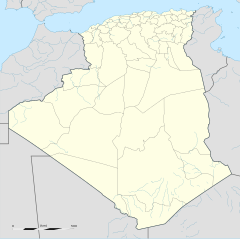Reggane series, French nuclear tests
| Reggane series | |
|---|---|
| Information | |
| Country | |
| Test site | Reggane, French Algeria |
| Coordinates | 26°18′42″N 00°03′26″W / 26.31167°N 0.05722°W |
| Period | 1960–1961 |
| Number of tests | 4 |
| Test type | Atmospheric |
| Device type | A-bombs |
| Max. yield | 70 kt (292.88 TJ) |
| Test series chronology | |
The Reggane series was a group of 4 atmospheric A-bomb nuclear tests conducted by France between February 1960 and April 1961, close to the end of the Algerian War.[1] The bombs were detonated at the Saharan Military Experiments Centre near Reggane, French Algeria in the Sahara desert region of Tanezrouft, by the Nuclear Experiments Operational Group (GOEN), a unit of the Joint Special Weapons Command.[2] The series saw the explosion of the first French nuclear weapon and was followed by the In Ekker series.
The French authorities claimed that the tests took place in an uninhabited area, but at least 27,000 people living in the vicinity were negatively impacted. The radioactive fallout caused elevated levels of skin cancer, birth defects, organ cancers and blindness among the local population.
Codenames
[edit]All four operations were named after the jerboa (Gerboise), a desert rodent found in the Sahara, with the adjunction of a colour. The first three colours adjuncted (blue, white and red) are said to come from the French Flag.[3]
Chart of the tests
[edit]| Codename | Date time (UTC) | Location | Elevation | Altitude | Delivery | Purpose | Device | Yield | Fallouts[a] |
|---|---|---|---|---|---|---|---|---|---|
| Gerboise Bleue | 1960-02-13 – 07:04:00.0 | CESM, Reggane, French Algeria 26°18′42″N 00°03′26″W / 26.31167°N 0.05722°W |
235 m | +100 m | Tower |
|
M1[b] | 70.0 kt | After 1 hour :
|
| Gerboise Blanche | 1960-04-01 – 06:17:00.0 | CESM, Reggane, French Algeria 26°09′58″N 00°06′09″W / 26.16611°N 0.10250°W |
235 m | 0 m | Concrete pad |
|
P1 | 3.0 kt | After 1 hour :
|
| Gerboise Rouge | 1960-12-27 – 07:30:00.0 | CESM, Reggane, French Algeria 26°21′11″N 00°07′24″W / 26.35306°N 0.12333°W |
235 m | +50 m | Tower |
|
P2 | 2.0 kt | After 1 hour :
|
| Gerboise Verte | 1961-04-25 – 06:00:00.0 | CESM, Reggane, French Algeria 26°19′15″N 00°04′24″W / 26.32083°N 0.07333°W |
235 m | +50 m | Tower |
|
R1 | 0.7 kt | After 1 hour :
|
| References : [4][5][6][7][8][9][10][11] | |||||||||
Human impact
[edit]The French authorities claimed that the tests took place in uninhabited areas, but thousands of people lived in the vicinity and were not properly warned of the tests.[12]
The tests left "a legacy of uncontained radiation that is still crippling inhabitants", with the radioactive plutonium causing higher levels of skin cancer and other afflictions.[12]
During the 1970s, babies in southern Algeria began to be born with birth defects, including atrophied limbs, while those that had witnessed the tests were affected by organ cancers and blindness.[12]
France’s Ministry of Defence estimated that 27,000 Algerians were impacted by the test, although there were a total of 60,000 people living in the area at the time.[12]
See also
[edit]- List of nuclear weapons tests of France
- Nuclear weapons and France
- Force de Frappe
- History of nuclear weapons
Notes
[edit]References
[edit]- ^ Senate of the French Republic (15 December 1997). "French Senate report #179: The first French tests in the Sahara". senat.fr (in French). Retrieved 8 August 2020.
- ^ Sokolski, Henry D.; Tertrais, Bruno (2013). Nuclear Weapons Security Crises: What Does History Teach?. Strategic Studies Institute and U.S. Army War College Press. p. 31. ISBN 978-1-5848-7574-1.
- ^ Kutchesfahani, Sara Z. (2018). Global Nuclear Order. Routledge. ISBN 978-1-3519-9962-5.
- ^ Radiological Conditions at the Former French Nuclear Test Sites in Algeria: Preliminary Assessment and Recommendations (PDF) (Technical report). Vienna: International Atomic Energy Agency. 1 March 2005. Retrieved 11 August 2020.
- ^ Report on French Nuclear Tests (1960-1996) (PDF) (Technical report) (in French). Government of the French Republic. p. 118. Retrieved 11 August 2020.
- ^ Yang, Xiaoping; North, Robert; Romney, Carl. Worldwide Nuclear Explosions (PDF) (Technical report). Science Applications International Corporation, Center for Monitoring Research. p. 20. Retrieved 11 August 2020.
- ^ Report on health and environmental hazards of France's nuclear tests between 1960 and 1996 [...] (PDF) (Technical report) (in French). Paris: National Assembly of the French Republic. 5 February 2001. p. 36. Retrieved 11 August 2020.
- ^ French Nuclear Testing, 1960-1988 (PDF) (Technical report). New York: Natural Resources Defense Council. February 1989. p. 26. Retrieved 11 August 2020.
- ^ Billaud, Pierre (1989). "L'Opération GERBOISE BLEUE (engin M1, 13 février 1960)" (in French). Retrieved 10 August 2020.
- ^ Billaud, Pierre (1989). "L'opération GERBOISE BLANCHE (engin P1, 1er avril 1960)" (in French). Retrieved 10 August 2020.
- ^ Billaud, Pierre (1989). "L'opération GERBOISE VERTE (engin R1, 25 avril 1961)" (in French). Retrieved 10 August 2020.
- ^ a b c d 61 years later, Algerians still suffer from France's atomic legacy
